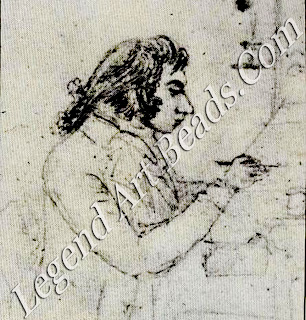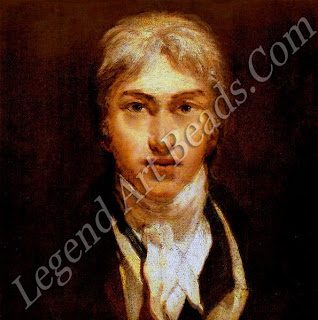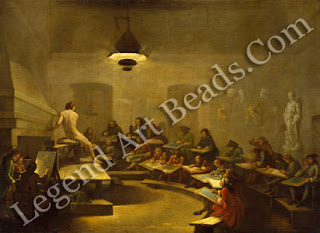Joseph
Turner was one of the greatest of all British artists. He worked extremely
quickly, but the brilliance and originality of his painting is unrivalled. By
the age of 30 he was a successful artist and a prominent member of the Royal
Academy, yet he remained a gruff, reclusive and intensely secretive character,
renowned for his unkempt dress and meanness with money.
Brought
up in London, he was fascinated by the Thames: water and ships were always his
strongest inspiration. The river-side area of the city remained his home base
all his life, but he travelled extensively-throughout Britain and Europe in
search of new dramatic landscapes to paint. When he died at the age of 76, he
left a vast legacy of over 20,000 works.
Key Dates
1775 born in Covent Garden, London
1790 exhibits first painting at RA
1799 elected associate member
of RA
1800 mother admitted to
Bethlem Hospital for the insane
1802 elected as full member of RA.
First trip to continent
1807 made professor of
perspective at RA
1819 first trip to Italy made
1,500 sketches in two months
1828 second visit to Italy
1829 death of father
1833 meets Mrs. Booth, his mistress
for life
1838 paints The Figlithrg
Tenieraire
1843 Ruskin's Modern Painters
published: a defence of Turner
1844 paints Rain, Steam and Speed
1851 dies in Chelsea
The Joseph Turner’s life
Genius at the Acaderny
 Despite
his abrupt, unconventional manner and daringly original style of painting,
Turner was proud of his prominence in the Royal Academy the home of Britain's
artistic establishment.
Despite
his abrupt, unconventional manner and daringly original style of painting,
Turner was proud of his prominence in the Royal Academy the home of Britain's
artistic establishment.
Joseph
Mallord William Turner was born on 23 April 1775. His father was a barber and
his mother the daughter of a butcher. They lived above his father's shop in
Maiden Lane, Covent Garden, and an area then, as now, closely associated with
the arts.
Little
is known of his mother except that she was prone to furious rages, which later
led to in-sanity. When Turner was 15 she was put into the Bethlem Hospital for
the insane and died four years later in a private asylum. Turner never spoke of
her in his adult life.
With
his father, on the other hand, Turner had a very close relationship. 'Dad never
praised me for anything but saving a halfpenny, he once re-marked. Nor was this
praise wasted, because Turner grew up to be both parsimonious and extremely
astute in all his financial dealings. In fact his father did encourage him in
other ways, not least by exhibiting his drawings in his shop.
As a
boy Turner came to love the river, which was within a few minutes' walk of his
home. The restless water of the Thames, the ever-shifting play of light on its
surface, fog and mist rising from it to veil the ships' sails and rigging, as
well as the business of the dockside, were scenes which haunted him all his
life. He saw something of the country-side too when he was sent, for the sake
of his health, to stay with his butcher uncle in Brentford, where he attended
the Free School.
Turner
received no definite education in art. Such training as he did pick up,
however, cornbined with his great natural talent, were enough to qualify him,
at the age of 14, for free tuition at the Royal Academy school. The following
year, 1790, he successfully submitted a drawing for the Academy's annual
exhibition. During the next ten years he not only worked hard, but learnt fast,
and soon attracted both critical approval and patrons.
 While
at the Royal Academy he studied with Thomas Malton, who painted detailed
water-col-ours of architectural subjects. And for three years from 1794, Turner
worked at the 'Monro School', copying other artists' works for 2/6 an evening.
Among the artists whose work he copied was JR Cozens. Turner's contemporary
(and rival) Thomas Girtin copied the outlines; Turner added water-colour
washes. Cozens' wild, romantic landscapes from Switzerland and Italy seem to
have inspired the young artist to see and paint such scenes himself. By 1798 he
was able to say that he had more commissions than he could fulfil.
While
at the Royal Academy he studied with Thomas Malton, who painted detailed
water-col-ours of architectural subjects. And for three years from 1794, Turner
worked at the 'Monro School', copying other artists' works for 2/6 an evening.
Among the artists whose work he copied was JR Cozens. Turner's contemporary
(and rival) Thomas Girtin copied the outlines; Turner added water-colour
washes. Cozens' wild, romantic landscapes from Switzerland and Italy seem to
have inspired the young artist to see and paint such scenes himself. By 1798 he
was able to say that he had more commissions than he could fulfil.
A MOROSE, SECRETIVE CHARACLER
In
stature Turner was short, and he later grew stocky and heavy, though he never lost
his formidable energy. His face was dominated by a prominent nose and a pair of
vigilant eyes. Most portraits show him to have been somewhat dishevelled,
probably the result of his lifelong habit of saving money by buying cheap
clothes. In manner he was abrupt and taciturn, even morose, and only revealed
the warmer side of his character with people he knew very well. He allowed an
air of mystery to surround his working methods and he was notoriously secretive
about his private life.
Writer - A Marshall Cavendish
 Despite
his abrupt, unconventional manner and daringly original style of painting,
Turner was proud of his prominence in the Royal Academy the home of Britain's
artistic establishment.
Despite
his abrupt, unconventional manner and daringly original style of painting,
Turner was proud of his prominence in the Royal Academy the home of Britain's
artistic establishment. While
at the Royal Academy he studied with Thomas Malton, who painted detailed
water-col-ours of architectural subjects. And for three years from 1794, Turner
worked at the 'Monro School', copying other artists' works for 2/6 an evening.
Among the artists whose work he copied was JR Cozens. Turner's contemporary
(and rival) Thomas Girtin copied the outlines; Turner added water-colour
washes. Cozens' wild, romantic landscapes from Switzerland and Italy seem to
have inspired the young artist to see and paint such scenes himself. By 1798 he
was able to say that he had more commissions than he could fulfil.
While
at the Royal Academy he studied with Thomas Malton, who painted detailed
water-col-ours of architectural subjects. And for three years from 1794, Turner
worked at the 'Monro School', copying other artists' works for 2/6 an evening.
Among the artists whose work he copied was JR Cozens. Turner's contemporary
(and rival) Thomas Girtin copied the outlines; Turner added water-colour
washes. Cozens' wild, romantic landscapes from Switzerland and Italy seem to
have inspired the young artist to see and paint such scenes himself. By 1798 he
was able to say that he had more commissions than he could fulfil. 












0 Response to "Joseph Turner – British Great Artist Life"
Post a Comment